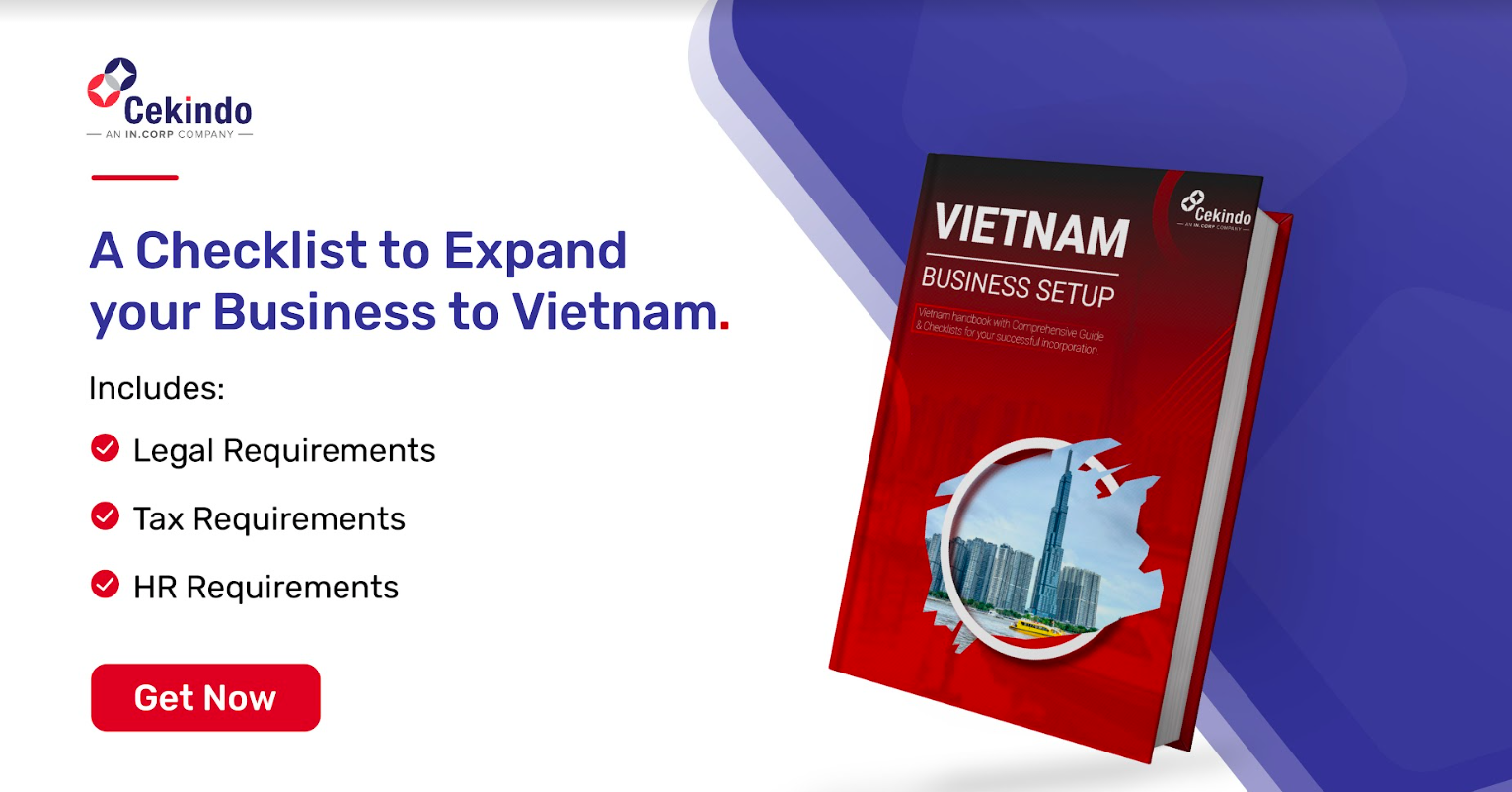- 1. A young & hungry fashion industry
- 2. Fintech gaining attention
- 3. E-commerce, the most promising in SEA
- 4. F&B, Hungry for more
- 5. Tourism Industry, a strong bounceback
- 6. Bright Future in Renewable Energy
- 7. Insurtech Vietnam, insurance of success
- 8. Technology in logistics and warehousing
- 9. Manufacturing & Vietnam’s path towards “industry 4.0”
- 10. Real estate, Land for Expansion
- 11. The Garment & Textile Industry
- Conclusion
With increasingly active trade and commerce deals, the ASEAN regional economy is growing well, despite a worldwide economic slump and a harsh business climate in light of the last two years overshadowed by a crippling global health crisis. ASEAN economies like Vietnam have astonished the global investment ecosystem with their rapid economic development and ability to rebound from the pandemic’s aftermath.
Don’t want to miss out on any opportunities? Check out Cekindo’s Company Registration Services
Vietnam’s Prime Minister recently indicated that economic growth would pick up in 2022 after falling short of predictions in the previous year, as the country works to recover from the aftermath of Covid-19, expecting the country’s gross domestic product to grow in a range of 6.5% in 2023. This sets a promising stage for foreign investors to expand into Vietnam in the coming years
This article will summarize Vietnam’s top ten business opportunities that await investors with an eye for success in 2023.
Here is a summary of what we think are the best business ideas for foreign investment based on current and projected economic and industry data.
1. A young & hungry fashion industry
Vietnamese consumers have long been drawn to the fashion sector. With sales in the clothing market of USD 4,872 million in 2021, Vietnam is one of the most promising grounds for business in sewing and materials.
As Vietnam’s middle class expands and their living conditions advance, their shopping demands become more sophisticated, increasing demand within the fashion business.
The advancement of technology, such as the introduction of supply chain analysis and user-behavior analysis, has aided companies in better understanding and developing product and customer-centric strategies. In addition, companies are increasingly focused on the consumer experience.
2. Fintech gaining attention
The Fintech sector in Vietnam has been on a fast growth track, trebling in size between 2017 and 2021. There are currently around 203 companies in the nation, offering a diverse variety of services such as digital payments, alternative finance, wealth management, and blockchain, among others. With over 4.2 million e-wallet users, digital payment remains the most popular area, accounting for 31% of fintech businesses.
Furthermore, for the foreseeable future, the market is likely to continue to rise at a quick rate. 94% of Vietnamese banks want to engage in Fintech in the coming year, making it one of the most potential areas for international investment.
Check out our latest guide: How to Set Up a 100% Foreign-owned Company in Vietnam
3. E-commerce, the most promising in SEA
According to a survey by Facebook and Bain & Company, Vietnam will be the fastest-growing e-commerce industry in Southeast Asia by 2026, with e-commerce Gross Merchandise Value (GMV) reaching 56 billion USD, 4.5 times the predicted value in 2021.
According to Vietnamplus, the annual SYNC Southeast Asia research polled 3,579 people in Vietnam, citing the nation as one of the strongest performers, with seven out of ten consumers having access to the internet and the country expected to have 53 million digital users by the end of 2021.
4. F&B, Hungry for more
According to a report published by Business Monitor International Ltd, Vietnam has emerged as one of the world’s most appealing food and beverage markets in 2019 (ranking 10th in Asia). In 2020, total income from food and beverage goods was USD 42 million (+3.8% YoY), accounting for 15.8% of GDP.
Furthermore, the savory snacks industry in Vietnam grows, with potato chips expansion expected at an exponential rate in terms of value, with the additional category of pretzels scheduled to increase in terms of volume between 2020 and 2025.
We made the most detailed step-by-step guide to setting up a business in Vietnam for investors, now available as an interactive checklist:
5. Tourism Industry, a strong bounceback
Foreign visitors to Vietnam fell to 3.8 million in 2018, down from 18 million in 2019. The tourism income hit $31 billion that year, accounting for 12% of GDP, with local tourists contributing the bulk. However, as a growing number of digital nomads and telecommuters exhibit an eager interest in the nation, the return to normalcy is expected to get Vietnam’s tourism back on track in a short period. The government aims for 5 million tourists to return in 2022 and a full resumption of up to 20 million tourists in 2023, at the pre-pandemic levels. As of the first 8 months of the year 2022, Vietnam welcomed 1.44 Million international visitors, the low number hampered by Visa limitations, which is expected to expand in 2023.
6. Bright Future in Renewable Energy
Vietnam aims for carbon neutrality by 2050, joining a long list of nations that have committed to halting emissions by the middle of the century or sooner to combat global warming. Moreover, Vietnam, Indonesia, Poland, and other major coal users pledged at the COP26 in Glasgow, Scotland, to gradually phase out the use of coal-fired power and put a restriction on building new plants.
The quantity of energy sold by Vietnam Electricity (EVN) has climbed from 128.6 terawatt-hours (TWh) in 2014 to 209.4 TWh in 2019, according to The Diplomat. Electricity consumption has been growing at more than 11% per year, well outpacing GDP growth. This hiked consumption is fuelling an insatiable desire for more electricity output, a move away from coal-fired power, and investments in renewable energy. Moreover, Vietnam generated 5% of its electricity from non-hydro renewable sources in 2020 according to Techwireasia.
7. Insurtech Vietnam, insurance of success
Vietnam’s overall insurance premium revenue has increased from USD 1 million in 2010 to USD 8 million in 2020. And since the insurance market is likely to grow significantly in the next few years, the InsurTech (Insurance Technology) sector is expected to grow as well.
Given that internet users in Vietnam are rapidly increasing – accounting for roughly 70% of the total population – entrepreneurs are attempting to develop new and innovative approaches to integrating technology and the insurance industry (InsurTech) to transform the way insurance companies conduct business and interact with their customers.
Related: A Comprehensive Guide to Importing to Vietnam
8. Technology in logistics and warehousing
After establishing itself as a major manufacturing base, Vietnam has risen three positions to eighth place in this year’s worldwide ranking of developing logistics markets. And with the advent of technology such as AI and automation, the logistics sector has been able to improve packaging, route optimization, and supply chain breakdown prediction.
AI is also a critical tool for warehouses’ day-to-day operations. Warehouses are expanding in size and accepting a wider variety of items. Overall, this, along with more automated warehouse operations, has resulted in significant waste reduction.
The growing demand for technology in Vietnam’s logistics and warehousing business has boosted demand for investment technologies such as Artificial Intelligence and Automation.
9. Manufacturing & Vietnam’s path towards “industry 4.0”
Vietnam has established itself as a prominent industrial base in the Asia Pacific during the last 15 years. Vietnam outperforms the worldwide average with manufactured products accounting for nearly 90% of national exports, well above the global average of 60%.
At the same time, Indonesia, Thailand, and Vietnam are all making headway toward Industry 4.0, with local governments developing an Industry 4.0 strategy and roadmap to boost local industrial competitiveness.
For instance, owing to Vietnam’s manufacturing prowess, the renowned Danish toy-maker Lego Group recently announced plans to build a new manufacturing operation in the country, with an investment of over USD 1 billion.
A High-tech Focus
With a look to diversify its manufacturing offering and attract more high-tech manufacturing, the Vietnamese government has made significant strides in improving its major infrastructure projects to improve logistical efficiency, connecting the factories to the ports, in addition to large port upgrades planned.
Attractive tax incentives also exist for tech manufacturing as well as high-tech transfer, from 0-15% corporate tax for the first 15 years of operations in the country. The standard CIT is a flat 20%.
10. Real estate, Land for Expansion
Despite the pandemic, Vietnam’s residential real estate market remains one of the fastest-growing in Southeast Asia, with new supply increasing 270% year on year in the first two quarters of this year (2021).
In Hanoi and HCM City, office real estate had occupancy rates of around 90%. These two cities are regarded as Asia’s most successful office marketplaces. In the near term, higher prices for land, villas, homes, and flats on the peninsula will raise prices in surrounding neighborhoods, particularly in Thu Duc City, and in the long run, across HCMC.
11. The Garment & Textile Industry
When it comes to demand within Vietnam’s manufacturing scene, the garment & textile industry is one of the biggest movers and shakers and these factories make up a massive percentage of Vietnam’s industrial parks. In 2021 alone, the value of Vietnam’s textiles, garment and footwear exports stood at an impressive USD39 Billion. Indeed both Nike and Addidas depend heavily on Vietnam as their most important source of manufacturing, with half of Nike’s total footwear products manufactured in the country and about 44% of Addidas’ total production came out of Vietnam, according to 2020 data reported by Britcham. What does this mean for investors? Vietnam is one of the most mature sourcing destinations within the garment & textile industry as well as the overall supply chain, backed up by its low cost of operations and salaries, providing plenty of business opportunities in Vietnam for manufacturers.
Conclusion
Vietnam’s economy prepares for a more assertive new year as 2023 approaches. The overall commercial environment remains positive as international businesses exhibit their interest in this rapidly-developing economy. With a full recovery already in full swing, foreign investors looking for a maturing, yet emerging marketing to capitalize on, now is the time.

